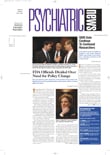The Supreme Court agreed last month with arguments made by APA and others that the juvenile death penalty is unconstitutional.
In Donald Roprer v. Christopher Simmons, the court voted 5-4 to affirm the 2003 decision by the Missouri Supreme Court that the state's juvenile death penalty law permitting the execution of individuals under the age of 18 violated the U.S. Constitution's Eighth Amendment prohibition against cruel and unusual punishment.
APA, the AMA, and the American Academy of Child and Adolescent Psychiatry were among those who applauded the Supreme Court decision. On the basis of scientific research, they had argued in an amicus curiae brief that adolescents' brains do not develop fully until adulthood and that adolescents' maturity, judgment, and decision-making abilities are not the same as those of adults (Psychiatric News, December 17, 2004).
“I'm pleased that the Court has recognized that executing juvenile offenders is cruel and unusual,” APA Trustee and child psychiatrist David Fassler, M.D., told Psychiatric News. “The decision acknowledges the growing body of research data demonstrating that the brains of adolescents function in fundamentally different ways from the brains of adults. Although many factors contributed to the Court's decision, I do believe that the emerging scientific consensus played a significant role. I also think it was important that a broad coalition of medical groups were able to speak with a unified voice.”
“The Supreme Court's decision confirms what we've known for some time: executing juveniles is unjust and inhumane,” said Michael Faenza, president and CEO of the National Mental Health Association, in a press release. “Youth are different from adults. They cannot—and now will not—be held to the same standards of culpability.”
The Court's ruling will spare the lives of Simmons and about 71 other individuals in 19 states that had permitted the juvenile death penalty for those aged 16 or 17, according to the Supreme Court opinion. The Court had already banned execution of youth aged 15 or younger.
Simmons was convicted of brutally murdering a neighbor in St. Louis, Mo., in 1993, when he was 17, and was sentenced to die. After the conviction, Simmons' new counsel alleged in appeals that Simmons had received inadequate counsel and assistance at trial and that matters related to his immaturity and impulsivity should have been established in the sentencing proceeding. The trial court found no constitutional violation in the assistance and counsel Simmons had received during his trial.
The Missouri Supreme Court affirmed the lower court's decision in 2001.
Simmons' attorneys saw another opportunity to appeal his case as a result of the U.S. Supreme Court case Atkins v. Virginia, decided in 2002. The court held that execution of individuals with mental retardation is prohibited. “Construing and applying the Eighth Amendment in the light of our `evolving standards of decency,' we therefore conclude that such punishment [the death penalty] is excessive and that the Constitution `places a substantive restriction on the State's power to take the life' of a mentally retarded offender.”
Simmons' attorneys appealed his case to the Missouri Supreme Court, arguing that the reasoning used in Atkins should also apply to cases in which a capital crime was committed when the murderer was under age 18.
The Missouri Supreme Court agreed and set aside Simmons' death sentence in favor of life imprisonment without eligibility for parole. The court also noted that a national consensus had developed against the execution of juvenile offenders under 18 since the Supreme Court decided the case Stanford v. Kentucky in 1989. That case was significant because it affirmed that states could execute 16- and 17-year-olds.
APA's Committee on Juvenile Justice Issues praised the Supreme Court for reversing its longstanding position on the juvenile death penalty last month.“ The committee has opposed the juvenile death penalty for several years and engaged in efforts to raise public awareness about the developmental differences between juveniles and adults,” committee chair William Arroyo, M.D., told Psychiatric News.
The APA committee also joined a coalition of national medical organizations in advocating against the juvenile death penalty. “There has been a groundswell of support for abolishing the juvenile death penalty in the last five years, especially since brain research on juveniles was published in the scientific literature. We now have brain-based evidence to explain the differences in thinking and maturity between adolescents and adults,” Arroyo said.
The Simmons case gained national and international attention. Briefs were filed in the U.S. Supreme Court last summer on behalf of Nobel Peace Prize laureates including former President Jimmy Carter, former Soviet President Mikhail Gorbachev, and the Dalai Lama; nine former U.S. diplomats; legal and religious institutions; and the European Union, according to the Supreme Court opinion.
“[O]nly seven countries other than the United States have executed juvenile offenders since 1990: Iran, Pakistan, Saudi Arabia, Yemen, Nigeria, the Democratic Republic of Congo, and China,” stated the Supreme Court decision. “Since then, each of these countries has either abolished capital punishment for juveniles or made public disavowal of the practice... .In sum, it is fair to say that the United States now stands alone in a world that has turned its face against the juvenile death penalty.”
The Supreme Court opinion in Roper, Superintendent, Potosi Correctional Center v. Simmons is posted online at<caselaw.lp.findlaw.com/cgi-bin/getcase.pl?court=US&navby=case&vol=000&invol=03-633>. The amicus brief that APA and other organizations joined is posted online at <http://www.abanet.org/crimjust/juvjus/simmons/ama.pdf>.▪
